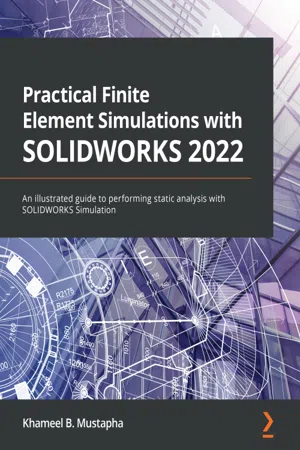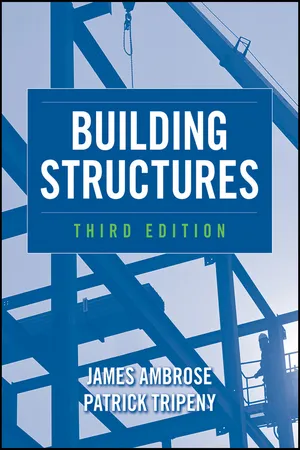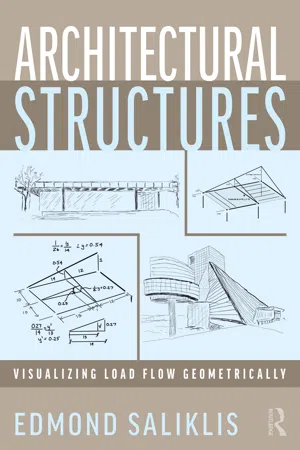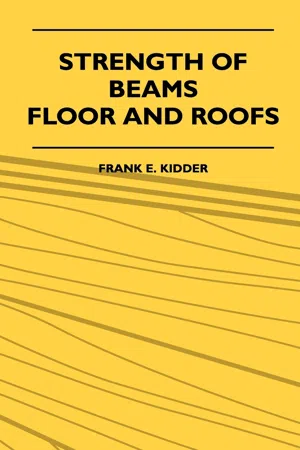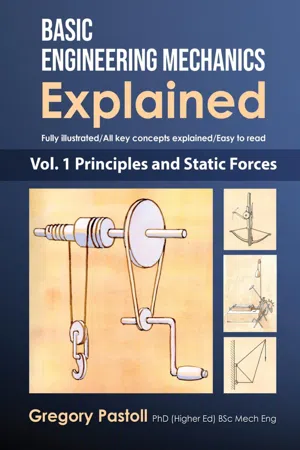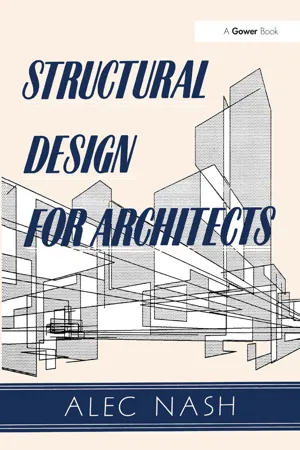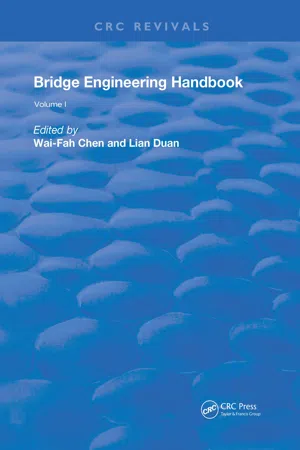Technology & Engineering
Simple Truss
A simple truss is a basic structural framework composed of straight members connected at their ends by joints. It is commonly used in engineering and construction to support loads over a span. The arrangement of the members and joints in a simple truss creates a stable and efficient structure for various applications.
Written by Perlego with AI-assistance
Related key terms
Related key terms
1 of 4
Related key terms
1 of 3
7 Key excerpts on "Simple Truss"
- Khameel B. Mustapha(Author)
- 2022(Publication Date)
- Packt Publishing(Publisher)
Let’s start with some basic definitions. A bar is a structure that is designed to support simple forces along its axis (such as tensile and compressive loads). On the other hand, a truss represents a collection of bars that are arranged as one or more units of triangulated frameworks. Discussions on the analysis of either of these types of structure (that is, a bar or a truss) often deserve separate standalone chapters. Nonetheless, since the analysis of bars is simpler than that of trusses, we shall allocate more time to the simulation of trusses with the understanding that the same knowledge carries over to the analysis of simple bars.NoteWithin the subject of mechanics, a structure broadly refers to a body or a collection of bodies designed to carry loads. Most structures are three-dimensional (3D ) in nature. But for ease of analysis, engineers often leverage approximations that facilitate the use of one-dimensional (1D ) members (such as a bar, a shaft, a beam, a column, and so on) or two-dimensional (2D ) approximations (such as plates and shells, and so on) to reduce the computational burden of complex 3D analyses.You will have seen the application of truss structures in various forms around you. Some of these are shown in Figure 2.1 . Typically, truss structures are featured prominently in the design of cranes, truss booms, telecommunication towers, masts, electric pylons, roofs, bridges, and so on.From an engineering performance analysis point of view, we conduct static analyses of bars and trusses with the following objectives:- Determining the internal forces and consequently the stresses that developed in the members
- Evaluating the axial deformation, the members experienced upon loading
In bars and trusses, the axial deformations manifest in the form of shortening (contraction) or lengthening (extension) of a member’s length. Consequently, a combination of compressive and tensile normal strains/stresses develops in these structures. Together, the stress and the deformation data that we retrieve from simulations help in determining the right geometric sizing for the members (called proportioning). But crucially, the results contribute towards our ability to design these structures to hedge against unwanted failure or excessive deformation during in-service usage. For brevity, in the rest of this chapter, we shall be using the term truss- eBook - ePub
- James Ambrose, Patrick Tripeny(Authors)
- 2011(Publication Date)
- Wiley(Publisher)
For relatively massive structures, such as large piers or very thick walls, confinement can enhance the strength with what may otherwise be relatively weak materials. Adobe (sun-dried mud) and other weak masonry may resist little compression when a single unit is crushed. Yet a thick construction is strong—mostly due to the confinement of the materials near the center of the mass.3.4 TrussesTrussing is essentially a means of stabilizing a framework of linear elements by arranging them in triangulated patterns. Figure 3.26 a shows a simple frame of four members with connections achieved with joints characterized as pinned . This type of joint is common in wood and steel structures, being one that can transmit direct or shear forces, but has little or no resistance to moment.Figure 3.26 Aspects of trusses.Under the action of lateral force, the frame shown in Figure 3.26 a will collapse sideways. The addition of the diagonal member, as shown in Figure 3.26 b , is a means of stabilizing the frame, the device being to reduce the rectangle to two triangles. The frame is thus converted to a vertically cantilevered truss.In a pure truss the members are all considered to be connected by pins, thus being subject only to axial tension or compression. In a truss of slender elements, with loads applied only at the joints, this condition is mostly true. However, in some situations joints may actually be quite rigid, members may be short and stout, and loads may be applied directly to members. For any of the latter conditions, the truss members may have significant additional structural actions, which must be added to those developed by truss functions.Interior triangulation is a basic necessity for a truss. In addition, the external supports must have certain qualifications. There must be sufficient reaction components for the stability of the truss, but the truss must also be allowed to deform freely under actions of the loads. Consider the truss in Figure 3.26 c , which is supported at its ends. Vertical reactions are sufficient for resistance to vertical loads. Horizontal reaction components are zero for vertical loading but are potentially useful for resisting any horizontal loads. With vertical loads, the bottom chord is subjected to tension and tends to elongate. This is not possible, however, if both of the supports resist horizontal motion; thus the truss as supported is not able to function properly. If one of the supports has its horizontal resistance removed, as shown in Figure 3.26 d - eBook - ePub
Architectural Structures
Visualizing Load Flow Geometrically
- Edmond Saliklis(Author)
- 2022(Publication Date)
- Routledge(Publisher)
4 TrussesDOI: 10.4324/9781003180913-4Two-dimensional trusses are defined as planar structures made up of individual straight elements, known as “bars”. Trusses are an unusual subset of structures in that they ultimately act as a beam, spanning long distances, yet the individual elements of the truss are assumed to never bend. It is important to understand that even though the overall structure bends like a beam and becomes concave up typically for gravity loads, the individual bars themselves remain straight and unbent. There are some idealized, mathematical assumptions about classical trusses:- The individual bar elements are assumed to be “hinged” at their ends, i.e. they cannot transfer bending to the subsequent member. This connection at the ends of truss elements is completely analogous to the “internal hinge” previously shown in Figure 2.23 of Chapter 2 .
- The individual bar elements are assumed to be weightless, i.e. they do not bend at all due to their lack of self-weight.
- Any loads applied to the truss may only be applied at the connecting points linking the bars together. These connecting points are called “nodes”. Loads may only be applied to the nodes of a truss, never to the bars directly. The reader can imagine that if loads were applied to the bars themselves, those bars would bend, which would violate the fundamental idealization of “no individual bars bend”.
- The individual bars experience only pure tension, or pure compression, no twisting, no bending. This is the hallmark of the truss’ efficiency; namely carrying load solely through tension and compression, as opposed to bending. This is a very efficient means of load flow, notice how open and airy the trusses of Figure 4.1
- Frank E. Kidder(Author)
- 2020(Publication Date)
- Mcmaster Press(Publisher)
It is therefore necessary to be able to design a truss for any conditions of span, loading or materials, so that we shall know with absolute certainty that it will safely carry the portion of the building supported by it and any pressure of snow or wind that may come upon the roof (with the possible exception of a cyclone), and that without using an unnecessary amount of material. To do this is not a very difficult matter, at least for the ordinary forms of wooden trusses, but it requires some study and practice, and cannot be learned from a thumb rule.In this and the following chapters the author has endeavored to discuss the subject of wooden roof trusses in as simple a manner as possible, explaining the way in which they should be built, the action of the various parts in transmitting the strains, the way in which the size of the pieces should be determined, and how they should be joined.DEFINITIONS .
In any discussion of trusses it is necessary to use certain terms, the meaning of which, as used by the author, must be clearly understood by the reader. In these chapters the term “truss” will be used to designate any frame work supported only at the ends (except in the case of a cantilever truss, which is supported near the center), and so designed that it cannot suffer distortion—that is, break away—without either crushing or pulling apart one of the members of which it is composed, and will exert only a vertical pressure on the walls or supports.A roof truss is a form of truss designed for the especial purpose of supporting a roof, although it may also support the ceiling below, and perhaps a gallery or one or more floors.By wooden trusses is meant trusses built principally of wood, but having iron or steel rods for some of the tension members, the term being used in distinction from trusses built entirely of iron or steel.A member of a truss is any straight or curved piece of wood or iron which connects two adjacent joints of a truss, and which is essential to the stability of the truss. The term “piece” will also frequently be used to designate a particular member.Every member of a true truss acts either as a strut or a tie.A tie is a piece of material that is subject to tension—that is, a pulling strain.A strut- eBook - ePub
Basic Engineering Mechanics Explained, Volume 1
Principles and Static Forces
- Gregory Pastoll, Gregory Pastoll(Authors)
- 2019(Publication Date)
- Gregory Pastoll(Publisher)
Chapter 7 Forces in structures: trusses and frames Definitions of a truss and a frame Definition of a pin-jointed truss Over-constrained structures Forces in the members of pin-jointed trusses Triangular stability Some standard bridge span structures in common use Determining by inspection whether a member will be strut or a tie Three methods of determining the forces in the individual members of a truss: The equilibrium of nodes; the method of sections; and using Maxwell diagrams Identifying no-load members Analysing simple 3-D trusses: the proportional technique Practical projects to build and test scale model trusses Definitions of a truss and a frameTrusses are structures made up of an open lattice-work (known also as a ‘web’) of members that are straight sections of material, joined at their ends. Such structures occur in roof trusses, bridges, crane jibs, crane booms, and electricity pylons.In a true truss, all the members are straight, joined only at their ends, in such a way as not to constrain members from rotating relative to one another, and all external loads are applied only at the nodes (joints). Each member can experience either tension or compression, but not bending.Frames are similar to trusses, except that one (or more) members of a frame extends beyond a node, so that such members can experience bending and shear in addition to tension or compression.An example of a frame: one or more members extend beyond two nodes, and forces may be applied between nodes.The material used for trusses and frames in large structures is usually steel, although other materials can be used, and the members can have any type of cross-section.Many older railway bridges were supported by timber trusses. Modern roofs still make use of timber trusses, where the spans are not too large. For smaller structures, as in machinery, aluminium or other alloys are sometimes used. - eBook - ePub
- A Nash(Author)
- 2017(Publication Date)
- Routledge(Publisher)
Chapter 4BEAM AND TRUSS SYSTEMSA truss appears to be a structural element in which small components are assembled into a larger form compatible with the distance to be spanned. Contemplation of the assembly process at once suggests a structural form totally different in kind from a beam. Nothing could be farther from the truth. The truss and the beam are analogous forms. Both are systems which, when used as horizontal members, displace vertical forces to positions of vertical reaction, thus attracting bending moments. Depending on which mental image is preferred, the truss can be thought of as a hollow beam, or the beam as a solid truss.Growth of solid beams
The fundamental structural logic underlying the adoption of a trussed form can be appreciated by considering what happens to the stress at the extreme fibres of a rectangular beam as it doubles its size. Figure 4.1 shows two such beams, one with depth d, breadth b, and span L, and the other with dimensions of 2d, 2b and 2L respectively. The weight density of the material, which is assumed to behave elastically, is denoted by the Greek letter γ.The equation relating bending and resistance moments, derived in Chapter 3 , can be manipulated to show how the bending moment at mid-span and the section modulus z - eBook - ePub
Bridge Engineering Handbook
Volume 1
- Wai-Fah Chen, Lian Duan, Wai-Fah Chen, Lian Duan(Authors)
- 2019(Publication Date)
- CRC Press(Publisher)
[2] .FIGURE 16.4 Typical truss members.The lateral members in the planes of the top and bottom chords resist wind loads and brace the compression chords. Sway frames are thought to square the truss and increase its torsional rigidity. End portals carry torsional loads resulting from uneven vertical loads and wind loads into the bearings.It is the visual impact of the various members, especially bracing members, which contribute to aesthetic opposition to many truss designs. However, if unforeseen events cause damage to a main truss member, these bracing members can serve as additional load paths to carry member load around a damaged area.Truss MembersSome of the cross sections used as modern truss members are shown in Figure 16.5 . Truss members have evolved from rods, bars, and eyebars to box and H-shaped members. Generally speaking, the box members are more structurally efficient and resist the tendency for wind-induced vibration better than H-shapes, whereas H-shapes are perceived as being more economical in terms of fabrication for a given tonnage of steel, generally easier to connect to the gusset plates because of open access to bolts, and easier to maintain because all surfaces are accessible for painting. The use of weathering steel offsets these advantages.Even in the late 1990s, box members are widely used and, in some cases, the apparent efficiency of the H-shape is offset by the need to make the members aerodynamically stable. The choice is clearly project specific, although the H-shaped sections have a relatively clear advantage in the case of tension members because they are easier to connect to gusset plates and easier to paint as indicated above, without the stability design requirements needed for compression members. They are, however, more susceptible to wind-induced vibrations than box shapes. Box shapes have an advantage in the case of compression members because they usually have lower slenderness ratios about the weak axis than a corresponding H-shaped member.
Index pages curate the most relevant extracts from our library of academic textbooks. They’ve been created using an in-house natural language model (NLM), each adding context and meaning to key research topics.
Explore more topic indexes
Explore more topic indexes
1 of 6
Explore more topic indexes
1 of 4
